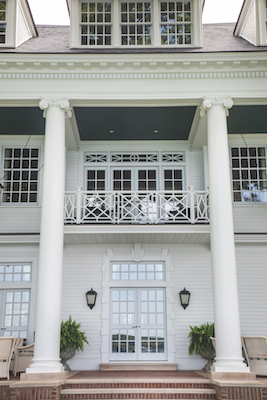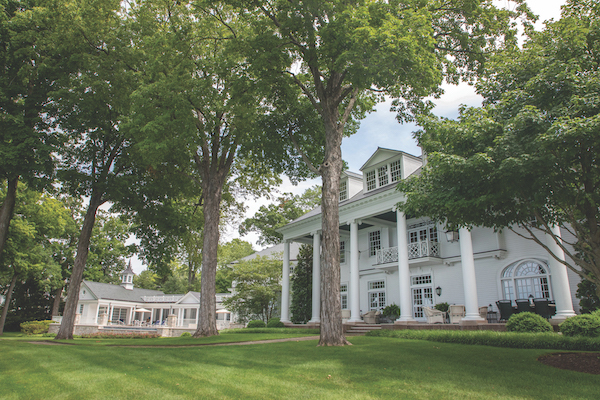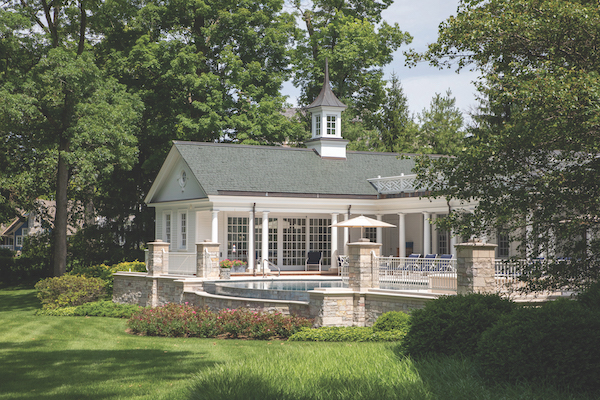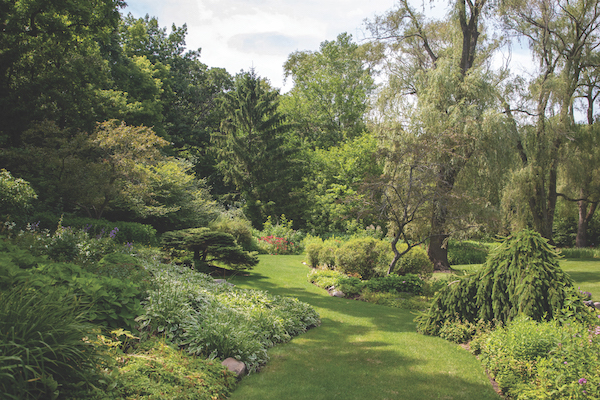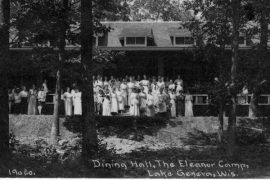By Sarah T. Lahey | Photography By Shanna Wolf
Editor’s note, Nov. 6, 2023: This estate is currently on the market for $30 million, the most expensive home for sale in Wisconsin.
Nearly every tour of Geneva Lake conducted by Lake Geneva Cruise Line passes by Aloha Lodge, and those on board gaze at its opulent footprint and beautiful surroundings. The house sprawls lakeside along the south shore, a stunning structure with a pool house, lush gardens and amazing sunset views. In the center section of the home, a hidden gem of history remains: the original veranda and core building of the Tracy C. Drake estate. Although a number of changes and additions have been made, this 120-year- old home remains largely intact. The white pillars marking the colonial structure are a reminder of the home’s roots: elegance, family and a pure love of the lake.
EARLY MEMORIES OF THE DRAKES
Tracy Drake inherited much of his wealth from his father, John Burroughs Drake, a hotelier who made a name for himself as proprietor of Chicago’s Tremont House. John began managing the hotel in 1855, and by 1863 was a partial owner. His patrons included Abraham Lincoln and Ulysses S. Grant — along with most of the 1860 Republican National Convention. When the Great Chicago Fire destroyed the building in 1871, John Drake started two new hotels. He was no newcomer to taking risks. His father died when he was 11 — forcing young John to drop out of school and begin working. He later made his way up the ladder at various hotels in Ohio, before finally moving to Chicago. John B. Drake was the ultimate self-made man: the son of a harness worker who became a hotel magnate.
Tracy and his brother, John Jr., were the benefactors of their father’s success. However, the elder John Drake did not spoil them. He took pride in training his sons “from the ground up,” teaching them about all aspects of the hotel industry.
During his teenage years, young Tracy Drake woke at 5:30 a.m. to get to the farmer’s market for fresh produce, which he brought to the Grand Pacific Hotel. Mornings were spent in the kitchen, helping with food preparation and carving meat for the dinner service. Historians Ann Wolfmeyer and Mary Gage claim that Tracy could carve a 15-pound turkey in less than five minutes — and serve it with a smile. Afternoons were spent doing “upstairs work,” such as cleaning or making beds. Evenings were spent working hotel banquets.
Indeed, Tracy Drake must have spent all of his early years working, since he did not marry until he was nearly 30 years old (which was unusual in the 1890s). He finally married Annie Daughaday in January 1893 and spared no expense on the nuptials. After a farewell bachelor luncheon in Chicago, Drake traveled to St. Louis — along with 50 guests — on private train cars where his bride and the rest of the 20 members of the wedding party were waiting. It was reported in the St. Louis Post Dispatch that 2,000 invitations were sent for the wedding at Christ Church Cathedral. To ensure the day would always be remembered, Drake even had a statue carved of his wife in her wedding dress.
After seven happy years of marriage, the couple had a son, Carlos, and six years later they had another son named Francis. By the time the younger son arrived, the family was already settled at Geneva Lake. From the moment they moved into Aloha Lodge, one thing was clear: this house would be for family, especially the children.
BUILDING ALOHA LODGE
The move to Geneva Lake preceded the founding of Chicago’s Drake Hotel, and likely was funded by inheritance from John B. Drake, who passed away in 1895. Three years after his father’s death, Tracy Drake bought 12 acres of lakefront property from Arthur Kaye (owner of Kaye’s Park Resort). The Drakes fell in love with Geneva Lake after visiting their friends, Simeon and Elizabeth Chapin, who lived on the north shore of the lake at Flowerside Inn. In fact, Drake had Chapin to thank for a very expensive landscaping decision at Aloha Lodge.
During a ride with Chapin near Williams Bay, Drake encountered a magnificent grove of maple trees with brilliant red leaves. He was so struck by their beauty that he insisted on moving nearly one hundred of these large, mature trees to his own property. Chapin did not try to stop him. In the winter of 1899, Drake had the trees dug up and moved by bobsled across the ice to his new property. Rumor has it, the trees never turned bright red again — but rather a deep yellow.
Construction on Aloha Lodge began in 1900, and the family moved in during the spring of 1901. Architect Howard Van Doren Shaw designed the house in true colonial style, with white pillars rising three stories to support a portico facing the lake. The main floor boasted a living room spanning 40 feet, and the third floor held a large ballroom for parties. Ornamental glass inscribed with the home’s name: “Aloha Lodge AD 1900” was placed in the main entry door at the back of the house, where guests would have been greeted. The name was inspired by the estate’s sunset view, which reminded the Drakes of their visits to Hawaii.
The reverence for Hawaii ran deep for the Drakes, who had befriended the deposed Queen Lili’uokalani on their travels. She was the last sovereign monarch of the Hawaiian Kingdom, ruling until the kingdom was overthrown in 1893. One assumes they sympathized with her cause: namely, that the U.S. had meddled unfairly in Hawaiian affairs and caused the monarchy to fall. The Drakes even named their Geneva Lake steamboat Ka‘iulani, after the last princess and heir to the Hawaiian throne. Her aunt, Princess Kawananakoa, visited the Drakes at Aloha Lodge in 1915. The relationship with Queen Lili’uokalani and her family was not fleeting, but rather a bond of over 20 years.
LAKE LIFE IN THE EARLY 20TH CENTURY
Once settled at Aloha Lodge, the Drakes assimilated into the lake community. Tracy enjoyed the relatively new sport of golf, serving as chairman of the house committee at Lake Geneva Country Club asearlyas1902.Healsoservedassecretary and treasurer of the club in its early years (it was founded in 1895). Annie took an active interest in her gardens, earning prizes for lettuce and parsley at the 1905 mid-summer fair.
When not golfing, Tracy Drake could be found in his car. He owned one of the first automobiles ever seen at the lake, and apparently he liked to drive fast. He once took Yerkes Observatory physicist and friend Edwin Frost for a ride, and the Dartmouth professor claimed he barely made it to the train station alive.
For the most part, however, the Drakes focused on their family life during summers at Aloha Lodge. They hosted popular tent shows on their property, often with performances by their son, Carlos, and threw a large birthday party every year for Francis. They decorated the yard by hanging Japanese lanterns in the trees, hired storytellers and invited more than 50 children. At the conclusion of the party, a professional photographer took a picture of the entire group.
In 1918, the Chicago Tribune’s society pages were still running stories about the Drakes with headlines such as: “Drake Family has Week-End Party at Aloha Lodge.” (In this particular story, however, the party was for Carlos and his teenage friends.) Later visitors included actor Cary Grant, who was married to Tracy and Annie Drake’s granddaughter, the actress Betsy Drake. Grant visited several times, and apparently got locked into the telephone room on one visit.
The Drake family spent 21 consecutive summers at the lake and continued to spend time there until they sold the property in 1936. Mrs. Drake felt a special connection to it as the place where she had raised her boys, and she held onto the home as long as she could.
LIFE FATHER, LIKE SON
Ten years after settling at Geneva Lake, Tracy and his brother partnered in the hotel business by opening The Blackstone Hotel and Theater in 1910, followed by The Drake Hotel in 1920. Both Tracy and John understood the business and knew how to please their customers. For example, at The Blackstone, Tracy Drake once served up a kitten on a silver platter to a bride who claimed she had always wanted a cat.
The key was opulence. When they opened The Drake Hotel, the brothers hosted a party for 2,000 guests on New Year’s Eve. They invited all of “high society,” served lots of champagne, and soon the hotel became wildly popular. Famous guests of the 1920’s-era included Bing Crosby, Walt Disney, George Gershwin and Charles Lindbergh — all of whom enjoyed cocktails in the Gold Coast Room. All signs pointed towards success, until the stock market crash of 1929.
THE END OF AN ERA
The beginning of the Great Depression proved difficult for the Drake brothers. The family lost nearly all of their money in the market crash, and in June 1933 both brothers were evicted from their apartments at The Drake Hotel. The entire building had gone into receivership in 1932, and within a year the insurance company was foreclosing on the $4 million mortgage.
An interesting twist is that Annie Drake had refused — only a few years earlier — to sign a “wrap around” mortgage that grouped the hotels and Aloha Lodge into a single pool of assets. She wanted to protect the Geneva Lake home from financial mishap, which proved to be an uncanny move. The Drakes were able to hold onto Aloha Lodge until 1936, although just barely. They left with only their personal effects; all of the furniture as well as the rugs, clocks and paintings stayed with the estate to cover the debt.
Luckily, many of these items remained with the house with its successive owners.
As late as the 1970s, owner Jim Long found Persian rugs and paintings in the upper attic. Long spent considerable time restoring the home to its historic roots, even moving the statue of Annie Drake in her wedding dress to its original place in the living room. Long also found a sculpture of Drake’s granddaughter, Betsy, which originally graced the entrance to the house.
Later owners were equally invested in the history of Aloha Lodge but made some improvements. For example, the third-floor ballroom was converted into a children’s playroom, complete with pull-out beds and an indoor treehouse. The latter included paper-mâché branches and a painted mural of leaves on the ceiling. This fanciful room entertained a new generation of children at Aloha Lodge, which certainly would have pleased Annie Drake.
ALOHA’S AFTERLIFE
When Annie Drake passed away in 1951, 12 years after her husband, Tracy, her obituary directed mourners to send donations to the Lake Geneva Fresh Air Association in lieu of sending flowers. This final wish is a testament to her attachment to Geneva Lake, and her sons apparently felt the same way.
In 1978, Carlos Drake returned to Aloha Lodge for a six-week visit with then-owner Jim Long. Details of the visit appeared in the Lake Geneva Regional News. In the interview, Carlos said that he and his brother “loved every minute of growing up at Lake Geneva.” Aloha Lodge had a special charm to it, and it would always be a place he called home.
Milestones in the Drake Family
- 1855 – John B. Drake founds the historic Tremont House
- 1893 – Tracy Drake marries Annie Daughaday
- 1898 – Tracy Drake buys Geneva Lake property
- 1899 – Drake moves 100 trees from Williams Bay to Aloha Lodge property
- 1900 – Son Carlos Drake is born 1901 – Aloha Lodge construction is complete
- 1906 – Son Francis Drake is born (at Lake Geneva)
- 1910 – Drake brothers open The Blackstone Hotel
- 1920 – Drake Hotel opens on New Year’s Eve to a gala party for 2,000 guests
- 1933 – The Drake Hotel goes into foreclosure
- 1936 – Aloha Lodge is sold to Richard Lydy
- 1939 – Tracy C. Drake dies at age 75

